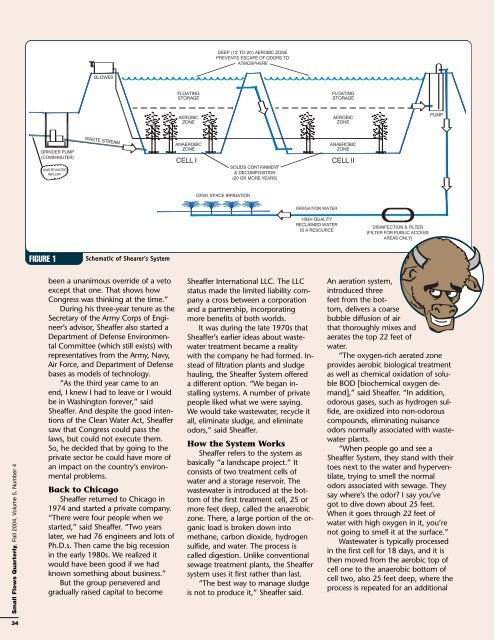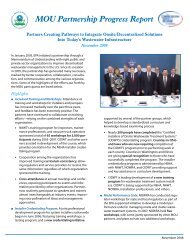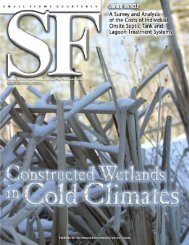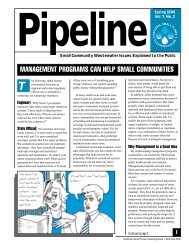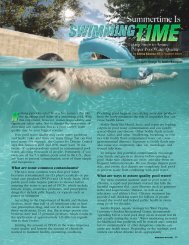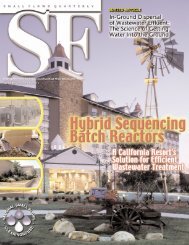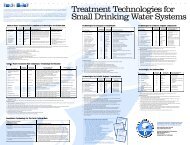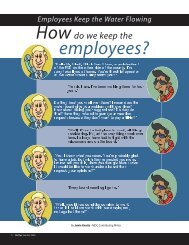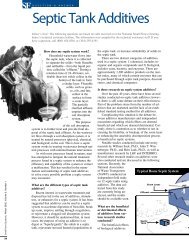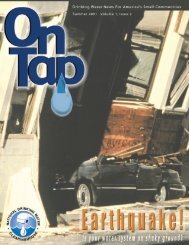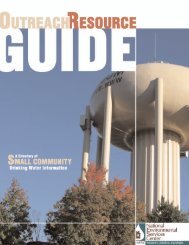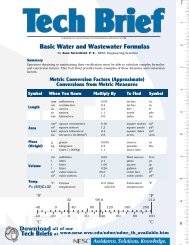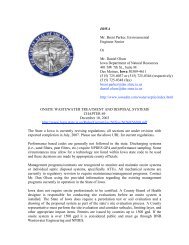Download - National Environmental Services Center - West Virginia ...
Download - National Environmental Services Center - West Virginia ...
Download - National Environmental Services Center - West Virginia ...
Create successful ePaper yourself
Turn your PDF publications into a flip-book with our unique Google optimized e-Paper software.
FIGURE 1<br />
Schematic of Shearer’s System<br />
Small Flows Quarterly, Fall 2004, Volume 5, Number 4<br />
been a unanimous override of a veto<br />
except that one. That shows how<br />
Congress was thinking at the time.”<br />
During his three-year tenure as the<br />
Secretary of the Army Corps of Engineer’s<br />
advisor, Sheaffer also started a<br />
Department of Defense <strong>Environmental</strong><br />
Committee (which still exists) with<br />
representatives from the Army, Navy,<br />
Air Force, and Department of Defense<br />
bases as models of technology.<br />
“As the third year came to an<br />
end, I knew I had to leave or I would<br />
be in Washington forever,” said<br />
Sheaffer. And despite the good intentions<br />
of the Clean Water Act, Sheaffer<br />
saw that Congress could pass the<br />
laws, but could not execute them.<br />
So, he decided that by going to the<br />
private sector he could have more of<br />
an impact on the country’s environmental<br />
problems.<br />
Back to Chicago<br />
Sheaffer returned to Chicago in<br />
1974 and started a private company.<br />
“There were four people when we<br />
started,” said Sheaffer. “Two years<br />
later, we had 76 engineers and lots of<br />
Ph.D.s. Then came the big recession<br />
in the early 1980s. We realized it<br />
would have been good if we had<br />
known something about business.”<br />
But the group persevered and<br />
gradually raised capital to become<br />
Sheaffer International LLC. The LLC<br />
status made the limited liability company<br />
a cross between a corporation<br />
and a partnership, incorporating<br />
more benefits of both worlds.<br />
It was during the late 1970s that<br />
Sheaffer’s earlier ideas about wastewater<br />
treatment became a reality<br />
with the company he had formed. Instead<br />
of filtration plants and sludge<br />
hauling, the Sheaffer System offered<br />
a different option. “We began installing<br />
systems. A number of private<br />
people liked what we were saying.<br />
We would take wastewater, recycle it<br />
all, eliminate sludge, and eliminate<br />
odors,” said Sheaffer.<br />
How the System Works<br />
Sheaffer refers to the system as<br />
basically “a landscape project.” It<br />
consists of two treatment cells of<br />
water and a storage reservoir. The<br />
wastewater is introduced at the bottom<br />
of the first treatment cell, 25 or<br />
more feet deep, called the anaerobic<br />
zone. There, a large portion of the organic<br />
load is broken down into<br />
methane, carbon dioxide, hydrogen<br />
sulfide, and water. The process is<br />
called digestion. Unlike conventional<br />
sewage treatment plants, the Sheaffer<br />
system uses it first rather than last.<br />
“The best way to manage sludge<br />
is not to produce it,” Sheaffer said.<br />
An aeration system,<br />
introduced three<br />
feet from the bottom,<br />
delivers a coarse<br />
bubble diffusion of air<br />
that thoroughly mixes and<br />
aerates the top 22 feet of<br />
water.<br />
“The oxygen-rich aerated zone<br />
provides aerobic biological treatment<br />
as well as chemical oxidation of soluble<br />
BOD [biochemical oxygen demand],”<br />
said Sheaffer. “In addition,<br />
odorous gases, such as hydrogen sulfide,<br />
are oxidized into non-odorous<br />
compounds, eliminating nuisance<br />
odors normally associated with wastewater<br />
plants.<br />
“When people go and see a<br />
Sheaffer System, they stand with their<br />
toes next to the water and hyperventilate,<br />
trying to smell the normal<br />
odors associated with sewage. They<br />
say where’s the odor? I say you’ve<br />
got to dive down about 25 feet.<br />
When it goes through 22 feet of<br />
water with high oxygen in it, you’re<br />
not going to smell it at the surface.”<br />
Wastewater is typically processed<br />
in the first cell for 18 days, and it is<br />
then moved from the aerobic top of<br />
cell one to the anaerobic bottom of<br />
cell two, also 25 feet deep, where the<br />
process is repeated for an additional<br />
34


